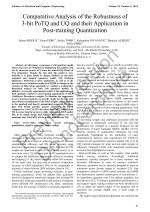| 4/2024 - 5 |
Comparative Analysis of the Robustness of 3-bit PoTQ and UQ and their Application in Post-training QuantizationNIKOLIC, J. |
| Extra paper information in |
| Click to see author's profile in |
| Download PDF |
Author keywords
computer simulation, intelligent transportation systems, machine learning, routing protocols, vehicular ad hoc networks.
References keywords
quantization(22), neural(13), training(9), learning(9), post(8), networks(8), uniform(6), processing(6), power(6), systems(5)
Blue keywords are present in both the references section and the paper title.
About this article
Date of Publication: 2024-11-30
Volume 24, Issue 4, Year 2024, On page(s): 47 - 56
ISSN: 1582-7445, e-ISSN: 1844-7600
Digital Object Identifier: 10.4316/AECE.2024.04005
Web of Science Accession Number: 001415806000005
SCOPUS ID: 85211320614
Abstract
In this paper, we propose a 3-bit quantizer model whose step sizes are obtained by multiplying the smallest step size by successive powers of 2, hence the name PoTQ (Power of Two Quantizer). Despite the fact that this model is non-uniform, it is quite simple to design, similarly to the most exploited and simplest quantizer model, UQ (Uniform Quantizer). Referring to these similarities, as well as to the non-existence of robustness analysis of SQNR to changes in the variance of data being quantized, we conduct a comparative theoretical analysis for both 3-bit quantizer models. In addition, we provide experimental results of the application of both quantizer models in post-training quantization of MLP (Multilayer Perceptron) weights. To illustrate the importance of our robustness analysis, we provide results for the case with and without normalization of the MLP weights, corresponding to the matched and heavily mismatched scenarios. We show that 3-bit PoTQ provides greater robustness of SQNR compared to 3-bit UQ. We also show that PoTQ outperforms UQ in preserving the accuracy of the compressed MLP model. Due to its simple design and superior performance, we can anticipate that 3-bit PoTQ will be widely used likewise UQ. |
| References | | | Cited By |
Web of Science® Times Cited: 0
View record in Web of Science® [View]
View Related Records® [View]
Updated 3 weeks, 5 days ago
SCOPUS® Times Cited: 0
View record in SCOPUS® [Free preview]
There are no citing papers in the CrossRef Cited-by Linking system.
Disclaimer: All information displayed above was retrieved by using remote connections to respective databases. For the best user experience, we update all data by using background processes, and use caches in order to reduce the load on the servers we retrieve the information from. As we have no control on the availability of the database servers and sometimes the Internet connectivity may be affected, we do not guarantee the information is correct or complete. For the most accurate data, please always consult the database sites directly. Some external links require authentication or an institutional subscription.
Web of Science® is a registered trademark of Clarivate Analytics, Scopus® is a registered trademark of Elsevier B.V., other product names, company names, brand names, trademarks and logos are the property of their respective owners.
Faculty of Electrical Engineering and Computer Science
Stefan cel Mare University of Suceava, Romania
All rights reserved: Advances in Electrical and Computer Engineering is a registered trademark of the Stefan cel Mare University of Suceava. No part of this publication may be reproduced, stored in a retrieval system, photocopied, recorded or archived, without the written permission from the Editor. When authors submit their papers for publication, they agree that the copyright for their article be transferred to the Faculty of Electrical Engineering and Computer Science, Stefan cel Mare University of Suceava, Romania, if and only if the articles are accepted for publication. The copyright covers the exclusive rights to reproduce and distribute the article, including reprints and translations.
Permission for other use: The copyright owner's consent does not extend to copying for general distribution, for promotion, for creating new works, or for resale. Specific written permission must be obtained from the Editor for such copying. Direct linking to files hosted on this website is strictly prohibited.
Disclaimer: Whilst every effort is made by the publishers and editorial board to see that no inaccurate or misleading data, opinions or statements appear in this journal, they wish to make it clear that all information and opinions formulated in the articles, as well as linguistic accuracy, are the sole responsibility of the author.



